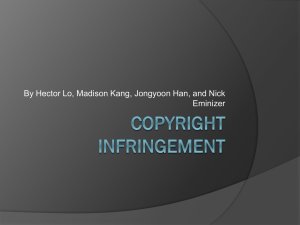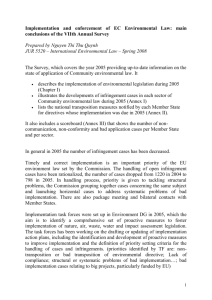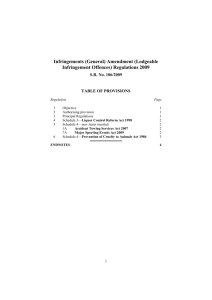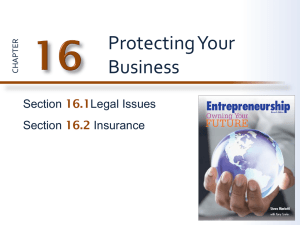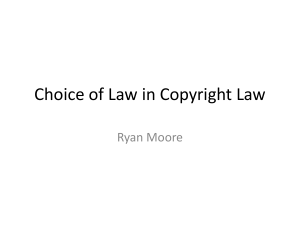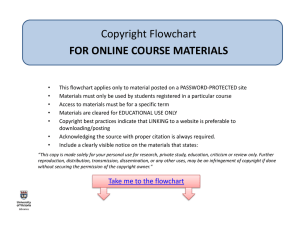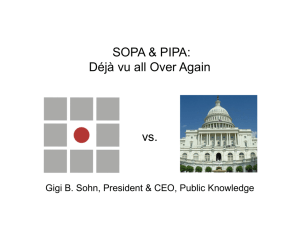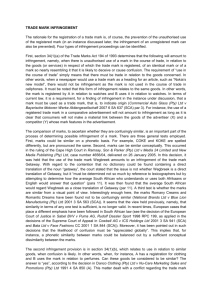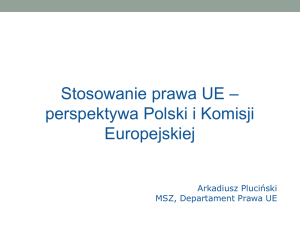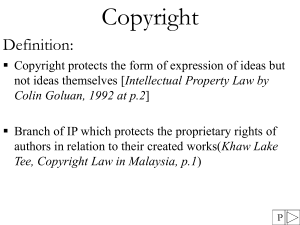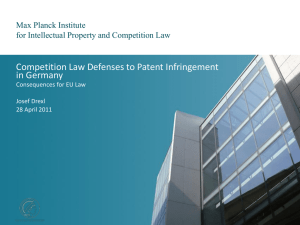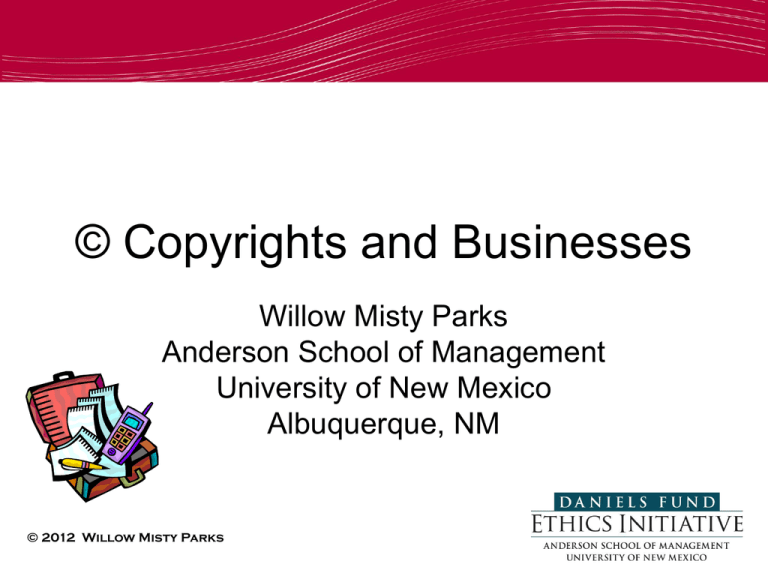
© Copyrights and Businesses
Willow Misty Parks
Anderson School of Management
University of New Mexico
Albuquerque, NM
© 2012 Willow Misty Parks
IMPORTANT NOTICE
• General legal information.
• This presentation is NOT legal advice
or legal representation.
• This presentation sets out general
concepts and some of the basics of
copyright law as it relates to business.
• Anyone determining that they need
legal advice or representation should
seek counsel and advice from an
attorney or law firm.
Significance of Intellectual Property
Law to Business
• Important to businesses!
• Violations of others’ rights can be costly, even if done
by an employee of the company
• Understand the basis of ownership of Trademarks,
Patents and Copyrights as business property and
assets
• Understand resources and legal uses available under
the law
• Understand when employers own employees’ works
Why This is Important
Current Issues
• Pirating and illegal downloading of music
and movies
• Borrowing images from the Internet
• Making copies for the classroom
• Business liability for customer and
employee infringements
Because of the Ease of Obtaining Rights
and Infringing on Rights
This is becoming an even greater issue today due
to:
-the myths about what constitutes a violation
-violations being inadvertent or due to
misinformation
-expanded employer/business liability for violations
by customers and employees
© is a Property right
• This is an intangible property right composed of 6
separable rights.
• Infringement is often difficult to define, detect,
deter and enforce.
• Identifying ownership: single owner, joint owners,
businesses/employers
• Rights may be transferred: bought, sold, rented,
through assignments and licensing.
• Rights may be exclusive or non-exclusive, written
or not.
• Rights may be inherited or given in wills and
trusts.
Intellectual Property is Property
• Property is property: whether tangible or
intangible
• Important to have respect for property rights
• Would not steal a tangible item from the store,
yet many download music and movies with no
remorse.
IP Law is Changing and Evolving
• Constitution of the United States
• The Copyright Act of 1976
• Sonny Bono Copyright Term Extension
Act of 1998
• Digital Millennium Copyright Act
(DMCA)
• Federal Trademark Dilution Act of 1995
The Copyright Clause
The Congress shall have Power . . . To
promote the Progress of Science and useful
Arts, by securing for limited Times to Authors
and Inventors the exclusive Right to their
respective Writings and Discoveries . . .
—Article I, Section 8, U.S. Constitution
Overlap & Intersection Intellectual Property
Laws
Patents
Trademarks ™
1.
1.
2.
3.
4.
5.
6.
7.
Covers systems, processes,
discoveries, etc.
Stronger protection
14 to 20 years
Must research history
New, obvious and useful
Requires registration
Patent attorneys (Patent Bar)
8.
Generally Expensive
2.
3.
4.
5.
6.
7.
Protects words, slogans,
phrases, logos, symbols, etc.
that identify products in the
marketplace
Unlimited time
Established through actual use
or registration
“Likelihood of confusion”
Cyber squatting
Dilution
May be registered with State
and/or Federal
Do You Own Any Copyright Rights?
Acquiring copyrights is easy!
You can do it without even being
aware of it.
Does anyone have a cell phone? With
pictures? You acquired copyright
ownership in those!
Acquiring © Copyright Rights
“original works of authorship fixed in
any tangible medium of expression”
Original & Fixed
Element 1: Originality
“original works of authorship”
1. Some minimal degree of creativity.
2. The requisite level of creativity is extremely
low; even a slight amount will suffice.
3. A creative spark.
4. Owes its origin; not copied.
Examples that Do NOT Meet Originality
• Phone books: the white pages; alphabetical order is not
enough!
• Maps: based on facts (unless the cities were imaginary
or false)
• There is NO “sweat-of-the-brow” doctrine in Copyright
Element 2: Fixed
“Fixed in any tangible medium of expression”
Fixed: is sufficiently permanent or stable for it to be perceived or reproduced for
more than a transitory duration.
Some examples of works NOT fixed:
Choreographic works, not notated or recorded
Improvisational speeches, not recorded
Performances, not written or recorded
Broadcasts, if not being simultaneously recorded
Pictures, writing or poem in the sand
Skywriting
Jazz improvisations
Improvisational political skits
Independent Creation
• A legal doctrine in which two or more may
own copyright in essentially the identical
work.
• Because of the ease of getting copyright
rights this may occur often.
• Unlike patents, each cannot stop the
others from using the other’s work.
• They must not have “copied” or known of
the other work.
Ideas Are Not Protected Under Copyright
• Copyright does not protect ideas, only the expression of
ideas.
• They may be protectable under Patent Law.
• The particular design or expression of the idea may be
protected.
The Copyright Rights: What Do You
Get?
Reproduce the work in copies
Prepare Derivatives
Distribute copies to the public for sale, rental, lease or
lending
Perform publicly*
Display publicly
*“publicly” display or performance occurs if it takes place at a place open to the public or at any
place where a substantial number of persons outside of a normal circle of a family and social
acquaintances are gathered.
Copyright Notice
• The symbol ©
• The year of first publication
• The name of the copyright owner
Example: © 2012 Willow Misty Parks
© Once a work is created notice may be placed. No registration
required.
© Notice is not required to obtain copyright rights for works
published after March 1, 1989. But highly recommended.
© Registration required to start an infringement law suit.
© Where there is valid © notice, no innocent infringers.
How Long Does Copyright
Protection Last?
For works created after January 1, 1978:
A. One author—life of the author plus 70
years
B. Joint works—life of last surviving author
plus 70 years
C. Anonymous & works made for hire:
– 95 years from publication, or
– 120 years from creation, which ever is first
Caveat: works created earlier or in foreign countries are
outside the scope of this presentation.
Copyright Registration:
Why Bother?
• Registration is NOT required to acquire rights!
• Prerequisite to being able to file an infringement lawsuit in
court.
• Establishes a public record.
• Timely* registration may permit statutory damages up to
$150,000, plus attorney fees and court costs.
• Evidentiary value of certificate of registration: rebuttable
presumption that copyright is valid, shifts burden of proof to
defendant to prove invalid.
* “Timely”= 3 months from publication or before infringement.
Who Owns Copyright?
Three Types of Ownership
1. One author/creator
–
–
Once it is fixed and original the individual creator owns it.
For the life of the creator plus 70 years
2. Joint or co-authors/creators
–
–
All contributors
On death of the last owner plus 70 years.
3. Works made for hire
–
–
If made by an employee, the employer/business owns it.
95 to 120 years depends on publication
Joint or Co-Authors/Creators
•
A work is jointly authored automatically upon its
creation if
1) two or more authors contributed copyrightable material to
the work; and
2) each of the authors prepared his or her contribution with
the intention (at the time the work was created) of creating
a single unitary work.
•
•
Each contributing author shares ownership of the
entire work.
Suggestion: a written agreement should be in place!
Works Made for Hire
In Scope of Employment
A work prepared by an employee within the scope of
employment is owned by the employer.
How to tell if the worker is an employee:
- Payroll formalities*
- Right to assign additional projects*
- Employee benefits*
- Tax treatment*
- Control manner and means of creation*
- Skill required*
- Instrumentalities and tools
- Location of work
* Most important factors
Types of Transfers: Assignments & Licenses
• Assignment: selling all your rights to another.
– If no rights are retained, original creator may NOT use the work
without permission from new owner.
• License: “renting” your rights to another; giving
permission to someone else to use your work.
1. You retain ownership
2. Licenses can be flexible documents
3. License specifics can limit:
–
–
–
–
portion of work that may be used
how/where the work may be used
duration of license
type of reproduction: i.e. film, VHS, DVD, CD, vinyl records, websites
Note: License or transfer agreement can be recorded with the Copyright Office.
Licenses: Permissions
• Exclusive—register!
1. The rights granted
may not be licensed to
anyone else.
2. Must be in writing,
and
3. Must be signed by the
owner of the rights.
4. Can register the
license with U.S.
Copyright Office.
•
1.
2.
3.
Non-Exclusive
No writing required.
Can be implied.
Cannot register with
U.S. Copyright Office.
4. Others can be
permitted to use the
work.
5. Owner can license
multiple users, and
6. Retain rights for
themselves.
Copyright Infringement
Copyright is a bundle of exclusive rights. Section 106 of the
copyright law provides the owner of copyright in a work
the exclusive right:
• To reproduce the work in copies;
• To prepare derivative works based upon the work;
• To distribute copies of the work to the public by sale or
other transfer of ownership, or by rental, lease or lending;
• To perform the work publicly;
• To display the copyrighted work publicly
• In the case of sound recordings, to perform the work
publicly by means of a digital audio transmission.
Copyright Infringement
Section 501 of the copyright law states that “anyone
who violates any of the exclusive rights of the
copyright owner ...is an infringer of the copyright or
right of the author.”
• The law does not enforce itself.
• You must bring own lawsuit.
• Registration is a prerequisite to an infringement
lawsuit.
The Most Common and Confusing…
• Derivative infringements
Common, Unintentional
Performance & Display Infringements
•
•
•
•
•
•
•
•
•
Key term is “publicly”
A public display or performance: if it takes place at a place open to
the public or at any place where a substantial number of persons
outside of a normal circle of a family and social acquaintances are
gathered.
Music’s special rules:* seek advice before playing in waiting rooms,
restaurants, school dances, weddings, etc.
Film festivals
Book readings, etc.
Fundraisers
School dances
Book covers
Playing a movie in a classroom*
Is limited by the “Right of First Sale”*
•
* See later slides for more details
•
Copyright Infringement
Infringement means violation of any of the exclusive
copyright rights
Possible remedies for © infringement:
–$ per violation of one work: $750-$30,000 as considered just
by the court.
–$ Innocent infringers: as low as $200 (this low penalty is not
available if © notice is on work because infringement is
considered intentional).
$ Statutory damages:
–$ At the court’s discretion for willful violations up to $150,000
per violation
–$ Actual damages and additional profits
–$ Impound & disposition of infringing articles.
–$ Potential criminal offences where infringement is willful.
Cease & Desist Notices
• Have to police and enforce Copyright Rights yourself
• Purposes:
- lets infringer know that you believe they are infringing
- establishes date of discovery
- tells infringer to stop
- gives a chance to explain, respond or negotiate
• Usually includes:
- Your name and contact
- Name of work, publication, copyright registration number
- Nature of activity that is in violation
- Demand the infringer to cease and desist future activity and pay you for
past damages.
- Request for response by stated date.
•Right of first sale
Some
to
•Fair
use,Exceptions
including parody
Infringements
Resources
•No blanket and
educational
•Public domain resources
There are several limitations of the exclusive
rights of the copyright owner. The copyright
law provides exemptions from infringement
liability by authorizing certain uses under
particularized circumstances. These
exemptions are enumerated generally in
sections 107-122 of the copyright law.
Some Exceptions to
Infringements and Resources
The Right of First Sale
Right of “First Sale”: the owner of a particular copy of a work
“exhausts” her economic rights therein—and thus loses control
of the copy—by selling it (Lee v. ART)
•
•
•
•
provides that the owner of the material object or copy can sell, give
away and sometimes lend it to the public without the copyright owner’s
permission (but cannot make additional copies)
The purchase of the art object itself is separate from the copyrights.
The mere ownership of a book, manuscript, painting, etc. does not give
the possessor the copyright.
The purchaser of a copy or object of art has the right:
- To sell
- To display (not publicly)
- To give away
- To lease, rent or lend to the public (except NOT computer programs and
sound recordings.)
Exception to Right of First Sale
• The right of first sale might not be applicable to
products produced overseas
• Publisher filed a lawsuit against a Thai student who
came to the U.S. and sold foreign-edition textbooks
on eBay. Courts determined that right of first sale
does not apply to this situation
• Student found to be guilty of copyright infringement in
lower courts
• Issue being considered by Supreme Court
• Could have significant implications for goods resold
on eBay and other global companies that sell used
goods
Is It Fair Use or Infringement?
First consider purpose: criticism, comment, news reporting,
teaching, scholarship, or research and parody
Four factors to be considered:
1.
2.
3.
4.
Purpose and character of the use, including whether it is
commercial nature of for nonprofit educational purpose
The nature or the copyrighted work (creative, fact, useful,
compilation)
The amount and substantiality of the portion used in relation to the
whole (a short quote or an entire article, the heart Y or the work)
The effect of the use upon the potential market for or value of the
copyrighted work.
Beware! No reliable general quantitative standards. If you are relying on
fair use to use someone else’s copyrighted work, be very, very
careful. Ultimately, only a judge or jury has the final say on whether
your use is “fair use” or not.
Erasing the Blanket Educational
& Nonprofit Myth
• There is NO blanket educational or non-profit exception to the
copyright.
• Movies played in class:
Performance or display of a legal copy of a work by instructors or
pupils in the course of face-to-face teaching activities or a
nonprofit educational institution, in a classroom or similar place
devoted to instructional use is not a copyright infringement.
• Textbooks: copies pose significant risks
• Course packets: have been heavily litigated
• Guidelines for copies of books or periodicals for classroom purposes
by not-for-profit educational institutions: 1. Brevity, 2. Spontaneity, 3.
Cumulative effect, and 4. A notice of copyright.
Theft of Music and Movies
• Illegally downloading music and movies is
serious!
• Many do not consider the seriousness of the
crime until they get caught
– Pirate Bay founder arrested
– Boston University student fined $675,000 for illegally
downloading 30 songs and sharing them on the
Internet
Parody & Fair Use
•
•
•
•
•
Practically by definition, you will NOT be able to obtain the author’s
permission for this use. Indeed, the owner of a work seldom wants to
license someone else to ridicule that work.
“Fair use” is the guarantee of breathing space within the confines of
copyright.
Parody: a literary or artistic work that imitates the characteristic style of
an author or a work for comic effect or ridicule—burlesque, satire,
criticism, raunchy twist and spoof.
Parody’s humor, its comment, necessarily springs from recognizable
allusion to its object through distorted imitation. Its art lies in the
tension between a known original and its periodic twin.
Mostly, reflected in the application of Factor 3 of Fair Use; thus, allows
more of the original to be used.
Public Domain Sources:
What Works Are in Public Domain?
“Public Domain” are works that for one reason or another are not
covered by copyright and are ordinarily free for all to use.
•
•
•
•
Works out of copyright: created before 1924 in the United States
Type of work not protected under copyright or patent/trademark
Work dedicated to public domain by owner
Improperly registered or not renewed works created before 1978
Examples: Hamlet, by William Shakespeare, Moby Dick by Herman
Melville, The 5th Symphony by Ludwig van Beethoven, (except for
recordings), Little Women, by Louisa May Alcott, Frankenstein by Mary
Shelley, Pride and Prejudice by Jane Austen, The Adventures of Tom
Sawyer by Mark Twain, etc.
Examples of
Public Domain Derivatives
Public domain work:
Still Available
• Novel “Little Women”
• Shakespeare’s
“Romeo and Juliet”
• 19th century oil
painting
New material:
Protected
• Dramatization for
television
• New introduction and
forward
• Reproduction of 19th
century oil painting by
photo lithography
Lessons for Businesses
• Businesses should train employees to
understand infringement and not to violate
• Have policies in handbooks as to ownership
of employee works and violations
• Provide notices for customers
• Don’t depend on fair use, get permissions
where possible, draw from public domain
sources, or develop own sources and works
made for hire
Lessons for Businesses
• Have clear employee contracts
regarding IP ownership
• Protect business property rights:
– Businesses should register copyright and
trademarks
– Draft and send Cease and Desist Letters
• Use copyright free and public domain
resources for development
Links
• US Patent and Trademark Office
http://www.uspto.gov/
• US Copyright Office:
http://www.copyright.gov/
• Fees:
http://www.copyright.gov/docs/fees.html
• Registration Form:
http://www.copyright.gov/forms/formco2d.pdf
Non-exclusive License Permission
Permission is granted under a non-exclusive license to copy and distribute this work to the Daniel’s
Foundation for purposes of education and classroom instruction. Permission is specifically denied
for commercial use, creation of derivatives, or otherwise for financial gain without specific written
permission from the author. No other entity or organization is given permission to copy, distribute,
make derivatives, display or otherwise use.
You are welcome to reprint any of my articles/presentations with the following conditions:
1. Include all Copyright Notices and Cautions
2. Articles/PowerPoints must be used in their entirety. Excerpts are acceptable pending permission.
3. If you are using an article online, all the copyright notices must be included.
4. Email distribution of this article must be to an opt-in email list only. NO SPAM!
Once you reprint or use an article/presentation, a courtesy copy of your publication or description of the use
would be appreciated:
Willow Misty Parks
PO Box 25312
Albuquerque, NM 87125
willowmistyparks@gmail.com
Willow Misty Parks,
Owner of the Business Bookshelf, LLC
©2012 The Business Bookshelf, LLC & Willow Misty Parks
Copyrights and all rights are reserved in aspects that are
original and fixed by the author, and to compilation,
organization and arrangement under the US Copyright Act,
except where the copyrights are owned by another, are under
GNU licenses, or do not have copyright as in Public Domain
and Federal Government works. Some works may be used
under the legal principle of Fair Use and the author makes no
representations of ownership to works that are currently
owned or protected under the Copyright Laws and therefore
gives no consent to any further uses including but not limited
to reproductions, display, distribution by any other parties. The
author takes no responsibility and will not be liable for any
unauthorized uses by others that may lead to violations of the
Copyright Act.

